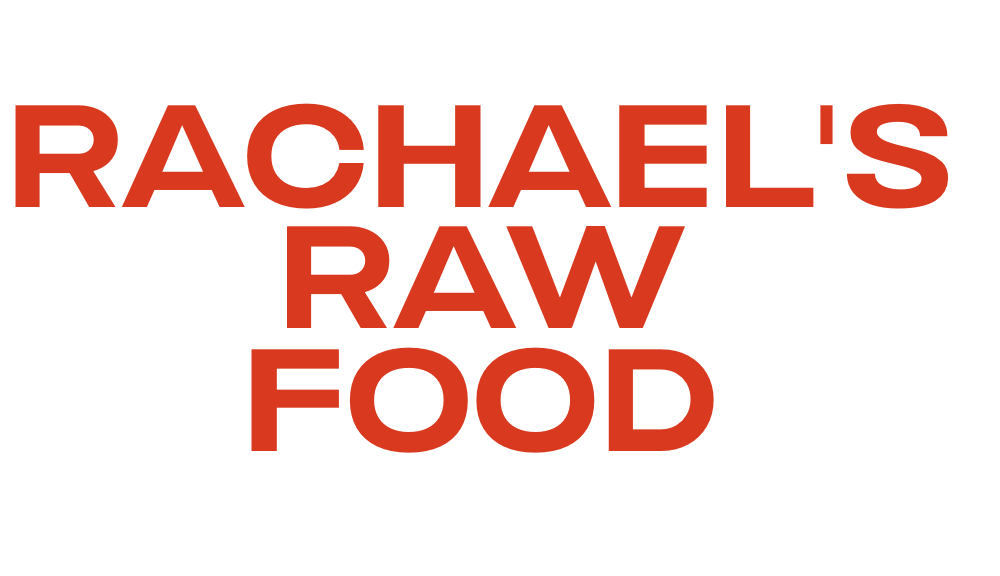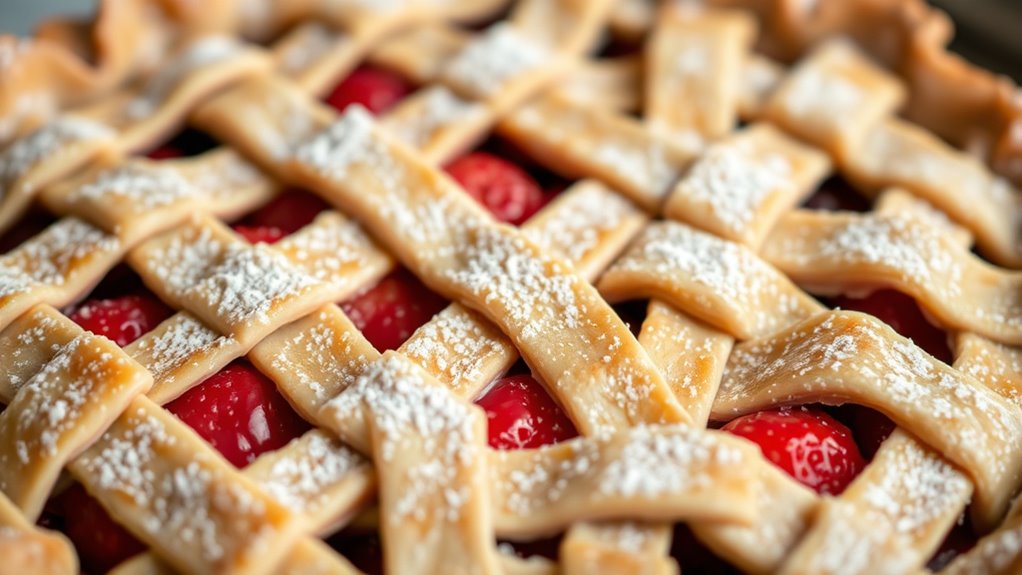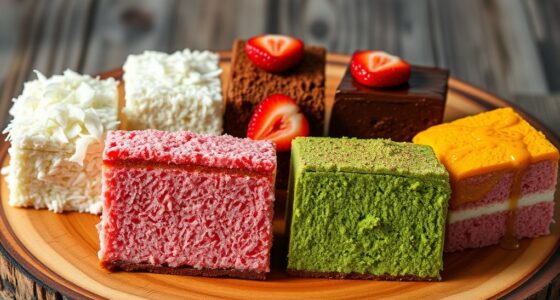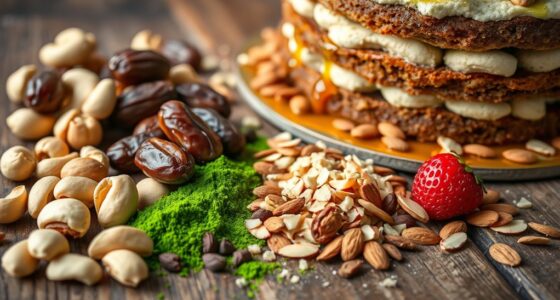To master raw pie basics, start with a simple crust made from blended nuts or seeds combined with a natural sweetener, then press it into a pan. For the filling, soak and blend nuts or seeds until smooth, adding fresh fruits, herbs, or sweeteners to enhance flavor. Chill the pie to develop texture and taste. Keep experimenting with flavors and ingredients to create custom treats. Continue exploring these techniques for more delicious, nutritious raw pies.
Key Takeaways
- Start with a simple, customizable crust using blended nuts, seeds, and natural sweeteners pressed into the pie pan.
- Soak nuts or seeds to soften, then blend until smooth for a creamy, flavorful filling.
- Incorporate fresh fruits, herbs, or natural sweeteners to enhance flavor and achieve desired tartness or sweetness.
- Chill the assembled pie in the refrigerator to set the filling and develop flavors for optimal serving.
- Experiment with flavor combinations and textures to master personalized raw pie creations from crust to cream.
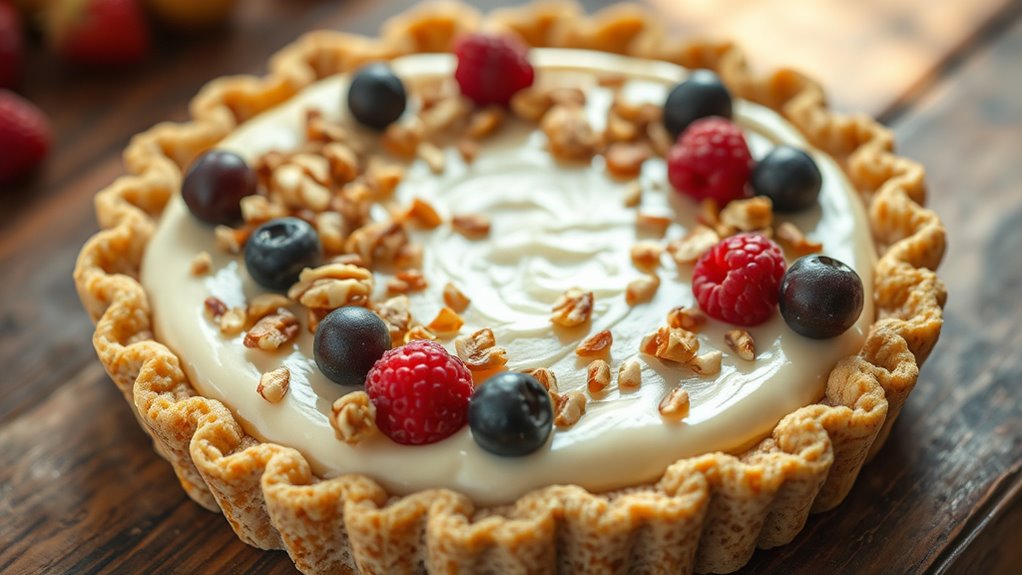
Raw pie is a delicious and healthy dessert option that requires minimal preparation and no baking. If you’re new to raw desserts, you’ll find that mastering the basics allows you to create treats that are both satisfying and nourishing. One of the key advantages of raw pie is its impressive nutritional benefits. Unlike traditional baked desserts, raw pies retain the natural enzymes and nutrients of their ingredients because they’re not subjected to high heat. This means you get more vitamins, antioxidants, and healthy fats in every slice, making it a smarter choice for your diet. Plus, raw pies often use whole, unprocessed ingredients like nuts, seeds, fresh fruits, and natural sweeteners, so you’re fueling your body with wholesome goodness.
Raw pie offers a nutritious, no-bake treat with wholesome ingredients that retain natural enzymes and vitamins.
When it comes to flavor combinations, raw pies are incredibly versatile. You can experiment with a variety of fruits, nuts, and spices to craft unique tastes that suit your preferences. For example, a classic raw pie might feature a base of dates and almonds blended into a crust, topped with a creamy filling made from cashews and flavored with lemon or vanilla. Or, you might try a berry and coconut combination for a vibrant, tropical twist. The beauty of raw pie is that the ingredients naturally complement each other, allowing you to play with different flavors without overwhelming your palate. Whether you prefer tart and tangy or sweet and rich, you can customize the flavor profile to fit your mood or occasion.
Creating the crust is straightforward. Typically, you’ll blend nuts or seeds with a touch of sweetener and a pinch of salt, then press this mixture into a pie pan. It’s easy to adjust the texture and flavor by changing the types of nuts or adding spices like cinnamon or cocoa powder. The filling usually involves soaking nuts or seeds to soften them and then blending until smooth. Adding fresh fruits, herbs, or natural sweeteners like honey or maple syrup enhances the flavor and nutritional profile. The key is balancing the sweetness with the tartness or richness of the toppings, so your pie is flavorful and satisfying. Additionally, using Vetted ingredients ensures you’re choosing quality components that contribute to a healthier dessert.
Once you’ve assembled your raw pie, it’s best to chill it in the refrigerator. This helps the flavors meld and the texture to firm up, making it easier to slice and serve. With practice, you’ll develop a sense of which ingredients and flavor combinations work best for your taste buds. Raw pie is a fantastic way to indulge in a dessert that’s both delightful and nutritious, all while keeping prep simple and ingredients fresh. It’s a versatile, health-conscious treat that you can adapt endlessly, making it a perfect addition to your culinary repertoire.
Frequently Asked Questions
Can Raw Pies Be Stored Safely for Later Consumption?
You can store raw pies safely for later if you follow proper storage safety and refrigeration tips. Keep the pie covered in an airtight container or wrapped tightly with plastic wrap to prevent contamination. Refrigerate it promptly at or below 40°F (4°C) and consume within 24-48 hours for maximum freshness. Avoid leaving it out at room temperature for extended periods to prevent bacterial growth and guarantee it’s safe to enjoy later.
What Are Common Substitutes for Traditional Pie Crust Ingredients?
Who knew that ditching traditional pie crust ingredients could be so adventurous? You can swap out refined flours for alternative flours like almond or coconut, adding flavor and nutrition. Instead of sugar, try natural sweeteners like honey or maple syrup for a healthier twist. These substitutes not only elevate your raw pie but also make it more wholesome. It’s a fun, creative way to enjoy your favorite desserts guilt-free!
How Do Flavor Combinations Vary With Different Raw Fillings?
When exploring raw fillings, you’ll notice flavor pairing choices influence taste and filling consistency. For fruity fillings, pairing bright berries with mint or citrus enhances freshness, while creamy nut-based fillings benefit from warm spices like cinnamon or cardamom. You can also experiment with savory elements, such as herbs or garlic, for unique flavor combinations. Adjusting ingredients helps balance flavor pairing and achieve the desired filling consistency, making each raw pie uniquely delicious.
Are There Specific Dietary Restrictions for Raw Pie Recipes?
When you wonder about dietary restrictions for raw pies, you’ll want to watch out for gluten-free options and nut allergies. You can easily substitute gluten-free oats or seeds for traditional crusts and choose nut-free fillings to keep everyone safe. Always double-check ingredient labels and be mindful of allergies. By customizing recipes, you create delicious, diet-friendly raw pies that satisfy, suit, and support everyone’s dietary needs.
What Equipment Is Essential for Preparing Raw Pies at Home?
To prepare raw pies at home, you’ll need essential equipment like knives and cutting boards for chopping ingredients, and a food processor to blend crusts and fillings smoothly. These tools make the process easier and more efficient, ensuring you achieve the right texture and consistency. With sharp knives, a sturdy cutting board, and a reliable food processor, you’re well-equipped to create delicious, raw pies from scratch.
Conclusion
Now that you’ve uncovered the secrets from crust to cream, you’re ready to craft your own raw pie masterpieces. Think of this journey as a simple alchemy—transforming raw ingredients into something delightful. With your newfound skills, you hold the key to creating desserts as timeless as the stories of old. So, go ahead, channel your inner culinary wizard, and turn everyday ingredients into magic—your raw pie adventure has just begun.
